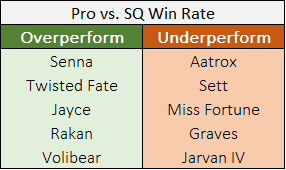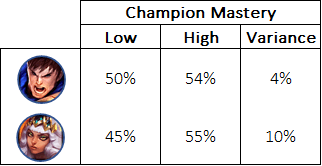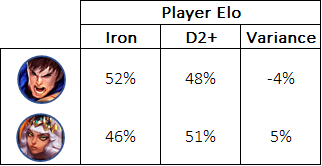LoL: Can Solo Queue data be used for Professional play

Photo by Tima Miroshnichenko
Each week, professional esports coaches, analysts and players ask these questions:
Who is going to be strong this patch? Who counters who? Which Champions scale the best?
There’s been no top-tier professional games (pro) yet this patch, so how do we answer them? Can we use data from solo queue (SQ)?
Note: All data is from u.gg, 9th June, Patch 12.11, all regions unless stated otherwise.
The Elo/Volume Trade-Off
Before we delve into this, I must make two obvious statements:
First, in general, the higher the SQ elo the better the games align to pro. A Challenger game more closely resembles pro than an Iron one.
Second, the more data available the more reliable these statistics become. For instance, to be confident that a 55% win rate Champion is actually better than one with 54% you’ll need at least 2,000 games on both.
The issue however, is that these two statements trade-off with one another. As I write this, Zeri has had 734 games in Gold yet only a measly 24 in Challenger. The more games I want to look at, the lower the elo has to go. When analysing SQ data you must choose a cut-off point. Is it Diamond III? Master? Rank 1–10 Challenger players?
I can’t provide a final answer here, although I will say that I typically use Diamond II+ and balance the data by having an equal amount of Master+ as Diamond I-II.
From here, assume when I refer to SQ data I’m applying some form of this elo/volume cut-off.
Champion Tier Lists: SQ vs. Pro
Let us start simple. Do solo queue win rates reflect professional play? If a Champion is atop the “Solo Queue Tier List Patch X.X”, will this be reflected in its pro performance?
The simple answer is, well, no.
For example, in Patch 12.8 Gwen had a SQ win rate of 50%, yet won 67% of games at MSI. This is one example of thousands across the years of solo queue & professional play. There seems to be no obvious correlation between the two.
However, that doesn’t mean the data is useless! Certain Champions consistently perform better in professional play than solo queue. If it’s consistent, then it’s predictable! Let’s bring this to life:
I looked at the last 2 ¹/₂ years of data and found Corki performed around 1.19x better in pro than his SQ win rate would suggest. That means, if he had a 45% win rate in SQ for this patch, you could predict that it will be around 53.5% in pro.
You won’t be right, but on average this method is more right than either a) assuming all Champions will have a 50% win rate or b) using SQ win rates directly.
It also means that if Corki was buffed and his SQ win rate suddenly rose by 5% — we could roughly assume that his professional performance will improve by c. 6% (5% x 1.19).
Note: I’ve simplified this for the article, there’s quite a bit of statistical magic that went into how we get to this 1.19x number — one for another time!
Here are the top 5 over and under performers over the years from this test:

Champions that highly over or under perform in Pro compared to their SQ win rates
Those in the left-hand column will regularly (with good sample size) perform better in pro than in SQ. Those in the right column see the opposite relationship and will underperform against their SQ statistics. For example, if Senna and Aatrox both had a SQ win rate of 50%, you would expect Senna’s pro performance to overperform (i.e. greater than 50%) and Aatrox to underperform (i.e. lower than 50%).
So, the question becomes: what is it about a Champion that lands it in one of these two columns?
I believe it can be boiled down to three key attributes:
- The Skill Ceiling
- Communication & Coordination
- Strategic Execution
The Skill Ceiling
Certain Champions are more difficult to play than others. There’s a difference between a perfectly executed Qiyana combo and a Garen spin-to-win. Here’s two ways of capturing it statistically:
Mastery vs. Win Rate. Champions with a high skill-ceiling should see a more distinct differential in their win rates as the player spends more time playing the Champion. This is quite literally showing a Champion hitting their ceiling.

Garen vs. Qiyana: Win Rate variance by Mastery
Low vs. High Elo. Better players tend to be able to make full use of complex kits and so as the elo increases harder Champions tend to improve whilst easier Champions get worse.

Garen vs. Qiyana: Win Rate variance by Elo
In general, Champions with a higher skill ceiling tend to outperform in pro since they are being piloted by the very best players which only magnifies this effect.
A good example of this is Jayce, a Champion who has such a high ceiling that there’s even a common comparison of “Korean Jayce vs. NA Jayce”. This is essentially saying the “ceiling” is a professional Korean top laner (arguably the best globally) and anyone below that won’t make full use of the kit.
Communication & Coordination
Without a doubt the key difference between a Challenger SQ game and a professional one is how well synced up the teams are. This comes from both their experience playing together, and the fact that they’re in constant verbal communication. Certain Champion’s rely on information gaps and chaos more than others.
The primary example here is a general class of Champion: Assassins. They have a certain playstyle which is common across game titles. They play in the shadows, prefer isolated targets and make use of the element of surprise. Each of these become harder when the team you’re facing work as a cohesive unit.
Let’s say you’re playing Katarina in SQ. You push your wave in, roam to bot lane and pick up a double kill. Later, when team fights kick-off you lurk in the darkness, wait for the enemy to be distracted then blow-up the backline, hit the dabbing emote and type “/all ez”.
Here’s how that works in pro play:
“Kata’s roaming, back off”
“Kata’s flanking, care”
“Save your CC for Kata”
“KATA KATA KATA”
The core playstyle of this Champion is countered by professional play itself! Statistically I wasn’t sure how to capture this —any ideas welcome.
The other end of this scale would be Champions that thrive in coordinated play. Twisted Fate, for example, makes better use of working with his team than most since his ultimate allows him to quickly pair-up and make plays.
Strategic Execution
Technically, this sits under Coordination & Communication but I felt it’s worth calling out on its own.
A professional team has a coaching staff who, alongside the players, have come up with a strategy to win the game. Your randomly assorted SQ game does not. Certain Champions have specific win conditions, like needing to get ahead early (which I wrote about in a previous article on Snowballatility) or waiting until certain items.
A pro team is not only aware of these strategic goals, but should be actively working towards achieving them. As these goals become more specific and convoluted they become exponentially harder to pull off in SQ.
For instance, if I’m locking in Azir then one of my strategic goals may be “avoid the early 2v2s”. My coach tells this to my jungler and I. We purposefully get information on the enemy jungler’s pathing and make intentional decisions to avoid fighting over an early crab.
I lock Azir in SQ, I get shoved in early, my jungler dies in a 2v1 over scuttle. He question mark pings me a few times and types “ff mid afk”. Cool.
These three categories don’t encapsulate everything, but in general if a Champion has a high skill-ceiling, works well in coordinated team-play and works best with specific objectives — then they’ll outperform their SQ win rate and vice-versa.
“Other” Statistics
Outside of a simple SQ win rate, there’s lots of other statistics to be studied. Whether that’s how well one Champion counters another, how well they scale or their average gold lead at 10 minutes.
Each of these comes with it’s own list of caveats and necessary pre-treatments, which we don’t have time to go through today. However, in general I’ve found these statistics can be applied to professional play.
Kayle performs better in the late-game than the early-game, SQ or pro. Draven gets an early-game lead most games. Lissandra counters LeBlanc. The values will never perfectly match, but directionally they tend to be indicative.
A Closing Argument
I’ve had this same discussion many times over, whether with random Reddit users or LEC coaching staff. There are only two bad takes:
- SQ cannot be used in pro.
- SQ data perfectly correlates to pro.
I hope, by now that you don’t find yourself in either of these two buckets. However, if you’re still firmly in the former let me close with this:
Over the last few years I have been relentlessly building an Artificial Intelligence model to predict the results of professional games using draft (see my articles on itero.gg for more). That model is given lots of data, some of which is from SQ.
This model is evaluated on how accurately it predicts future games. I have found that if it uses SQ data it is significantly more accurate. The only way that happens is if the data it is seeing is providing significant value. I can therefore say with extreme confidence that you CAN use Solo Queue data in professional play, you just have to be smart about it!
Coming Soon: I briefly touched on a method I’ve designed to predict how well a Champion will do in pro on the current patch. During the Spring Split I tweeted out a few that I had a high degree of confidence with (and got them all pretty much right). I’ll be doing the same next week so if you want to see these predictions live in action, follow me on Twitter.